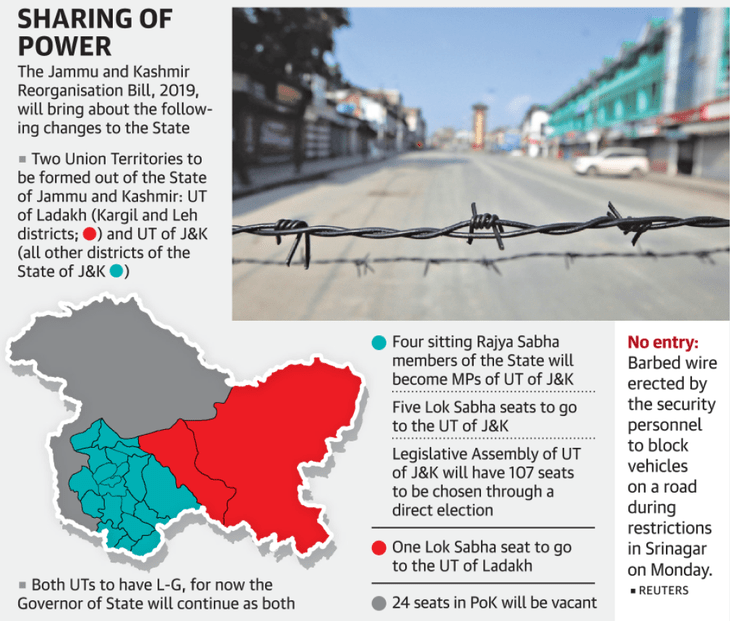Context
The Jammu and Kashmir Delimitation Commission has notified the new boundaries, names and number of Assembly constituencies in Jammu and Kashmir, paving the way for the first-ever Assembly election in the Union Territory.
Relevance
GS II- Polity and Governance (Federalism)
Dimensions of the article:
- Delimitation in J&K
- Delimitation Commission Act, 2002
- What changes have been made?
- Jammu & Kashmir Reorganisation Act, 2019
Delimitation in J&K
- Assembly seats in J&K were delimited in 1963, 1973 and 1995.
- Prior to August 5, 2019, carving out of J&K’s Assembly seats was carried out under the J&K Constitution and Jammu and Kashmir Representation of the People Act, 1957.
- Until then, the delimitation of Lok Sabha seats in J&K was governed by the Constitution of India.
- However, the delimitation of the state’s Assembly was governed by the J&K Constitution and J&K Representation of the People Act, 1957.
- There was no census in the state in 1991 and hence no Delimitation Commission was set up by the state until 2001 census.
Concerns raised over Delimitation in J&K
- Concerns had been expressed over how the delimitation process may end up favoring the Jammu region over Kashmir in terms of the seats.
- Arguments have been made on how Ladakh has been underrepresented, with demands for statehood/sixth schedule.
- It is argued that seats for STs should’ve been divided in both Jammu province & Kashmir province, as the ST population is almost equal.
Delimitation Commission Act, 2002
An Act to provide for the readjustment of:
- The allocation of seats in the House of the People to the States
- The total number of seats in the Legislative Assembly of each State
- The division of each State and each Union territory having a Legislative Assembly into territorial constituencies for elections to the House of the People and Legislative Assemblies of the States and Union territories
- and for matters connected therewith.
- Delimitation literally means the act or process of fixing limits or boundaries of territorial constituencies in a country to represent changes in population.
Delimitation is done in order to:
- Provide equal representation to equal segments of a population.
- Fair division of geographical areas so that one political party doesn’t have an advantage over others in an election.
- Follow the principle of “One Vote One Value”.
The problems with delimitation are:
- States that take little interest in population control could end up with a greater number of seats in Parliament. The southern states that promoted family planning faced the possibility of having their seats reduced.
- In 2008, Delimitation was done based on the 2001 census, but the total number of seats in the Assemblies and Parliament decided as per the 1971 Census was not changed.
- The constitution has also capped the number of Lok Shaba & Rajya Sabha seats to a maximum of 550 & 250 respectively and increasing populations are being represented by a single representative.
What changes have been made?
- The Commission has enhanced the number of Assembly seats in Jammu (to 43) and Kashmir (to one) (now 47). It has also changed the organisation of the existing Assembly seats dramatically.
- The borders of the Anantnag and Jammu seats have been changed by the Commission. The Pir Panjal region of Jammu, which includes the districts of Poonch and Rajouri and was previously part of the Jammu parliamentary seat, has now been included to Kashmir’s Anantnag seat. A Shia-dominated portion of the Srinagar parliamentary seat has also been relocated to the Valley’s Baramulla constituency.
- The Commission has recommended that at least two Kashmiri Migrants (Kashmiri Hindus) be represented in the Legislative Assembly.
- It has also recommended that Centre should consider giving representation in the J&K Legislative Assembly to the displaced persons from Pakistan-occupied Kashmir, who migrated to Jammu after Partition.
Why has the exercise been controversial?
- There have been concerns that the delimitation process may favour the Jammu region over Kashmir in terms of seat allocation.
- There have been arguments over how Ladakh has been underrepresented, with demands for independence and inclusion in the sixth schedule.
- It is stated that because the ST population is nearly equal in both Jammu and Kashmir, seats for STs should have been shared in both provinces.
- Delimitation for the rest of the country has been frozen until 2026, therefore only constituency boundaries in J&K are being redrawn. In J&K, the last delimitation exercise took place in 1995.
Jammu & Kashmir Reorganisation Act, 2019

- The Jammu and Kashmir Reorganisation Bill, 2019 was introduced in Rajya Sabha on August 5, 2019 by the Minister of Home Affairs, Mr. Amit Shah.
- The Bill provides for reorganisation of the state of Jammu and Kashmir into the Union Territory of Jammu and Kashmir and Union Territory of Ladakh.
- The Bill reorganises the state of Jammu and Kashmir into: (i) the Union Territory of Jammu and Kashmir with a legislature, and (ii) the Union Territory of Ladakh without a legislature.
- The Union Territory of Ladakh will comprise Kargil and Leh districts, and the Union Territory of Jammu and Kashmir will comprise the remaining territories of the existing state of Jammu and Kashmir.
- The Union Territory of Jammu and Kashmir will be administered by the President, through an administrator appointed by him known as the Lieutenant Governor.
- The Union Territory of Ladakh will be administered by the President, through a Lieutenant Governor appointed by him.
- The High Court of Jammu and Kashmir will be the common High Court for the Union Territories of Ladakh, and Jammu and Kashmir. Further, the Union Territory of Jammu and Kashmir will have an Advocate General to provide legal advice to the government of the Union Territory.
- The Legislative Council of the state of Jammu and Kashmir will be abolished. Upon dissolution, all Bills pending in the Council will lapse.
-Source: The Hindu





